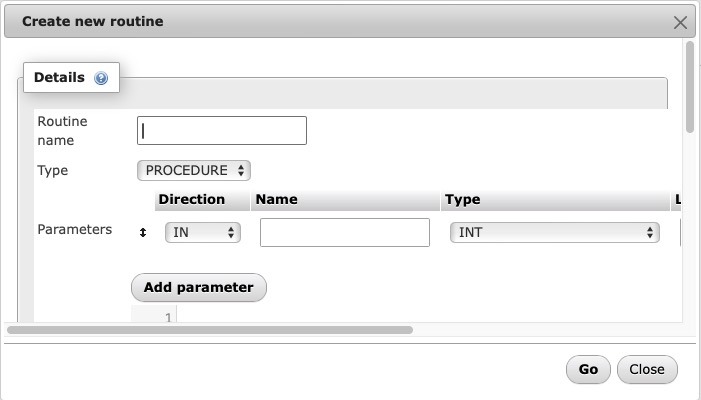Columnstore is an open-source, column-oriented database that is different from traditional storage models by implementing a vertically organized structure for data. Unlike row-based databases, columnstore databases have advantages in terms of speed, compression, and query performance. Columnstore is designed to handle large volumes of data efficiently and provide fast access to analytical reports.
Login
On your first visit to the site, you will be presented with the login/signup screen.

When your instance is first created, an account is created for you with the email you chose. You can get the password for this account by going to your Elestio dashboard and clicking on the "Show Password" button.
Enter your username and password and click the "Login" button.
SQL Editor
SQL is useful in columnstore because it provides a structured query language that allows for efficient and effective management and retrieval of data stored in column format. With SQL, you can easily write queries to filter, aggregate, and analyze data in a columnstore, enabling faster query performance and improved data compression. Additionally, SQL provides a standardized way to interact with columnstore databases, making it easier to integrate with other systems and tools in your project. You can start writing sql queries by clicking on the "SQL" tab in the top navigation bar.

Create New Routine
In Columnstore, a routine refers to a predefined set of SQL statements that can be executed repeatedly. It can be a stored procedure, function, or any other type of routine that performs a specific task or operation. Routines in Columnstore are used to automate common tasks, improve code reusability, and enhance overall database performance. You can create new routines by clicking on the functions or procedures under the database name and then clicking on the "Create Routine" button.

Creating New Event
An event is a specific occurrence or action that is captured and recorded within the database. Events can include various activities such as data modifications, system errors, user actions, or any other significant operation that needs to be tracked. These events can be used for auditing purposes, troubleshooting, performance analysis, or any other form of monitoring and analysis. You can also create events to trigger certain actions when they occur. You can create new events by clicking on the "Events" tab in the top navigation bar of the database you want to create event for.

Privileges
Privileges are access rights and permissions granted to users or roles for performing specific actions or operations on the database objects. Privileges control the level of access and functionality that a user or role has within the database. These privileges can include permissions to read, write, modify, or delete data, as well as the ability to create or modify database objects such as tables, views, routines, and events. By assigning appropriate privileges, administrators can ensure data security and enforce data integrity within the Columnstore database. You can configure privileges by clicking on the "Privileges" tab in the top navigation bar of the database.

Creating new Trigger
Trigger is a database object that is associated with a table and automatically executes a set of actions when a specific event occurs, such as an insert, update, or delete operation on the table. Triggers are commonly used to enforce data integrity, perform auditing or logging, or automate certain tasks based on data changes. They can be defined to execute before or after the event and can be used to modify data, perform calculations, or invoke other routines. You can create new trigger by clicking on the "More > Triggers" tab in the top navigation bar of the database.

Server Status
Status is a current state or condition of the database. It provides information about various aspects such as the database's health, performance, availability, and resource utilization. The status screen displays metrics and statistics related to the database, including the number of active connections, CPU and memory usage, disk space utilization, query execution times, and other performance indicators. Monitoring the status of a Columnstore database helps administrators identify any issues or bottlenecks and take appropriate actions to optimize the system's performance and ensure smooth operation. You can access the status screen by clicking on the "Status" tab in the top navigation bar.

Importing into Database
Import is the process of bringing external data into the database for storage and analysis. It allows you to load data from various sources such as files, databases, or streaming platforms into your Columnstore database. Importing data is an important step in populating your database with the necessary information for performing analytical queries and generating reports. The import process involves mapping the data from the source to the appropriate columns in the database.

Design
Design is process of structuring and organizing the database schema and tables to optimize performance and storage efficiency. It involves making decisions about the column types, indexing strategies, partitioning, and compression techniques used in the database. By carefully designing the database, developers can ensure that it meets the specific requirements of their application and maximizes the benefits of using a column-oriented storage model. You can access the design screen by clicking on the "Design" tab in the top navigation bar.

Page-related Settings
Page-related settings are configuration options that determine how data is organized and stored within the pages of the columnstore. These settings control factors such as the size of the pages, the compression algorithms used, and the maximum number of rows that can be stored in a single page. You can create database here and draw out the relationship between them making it easier to visualize the database and relationships between them. You can access the page-related settings by clicking on the gear icon in the top navigation bar.
